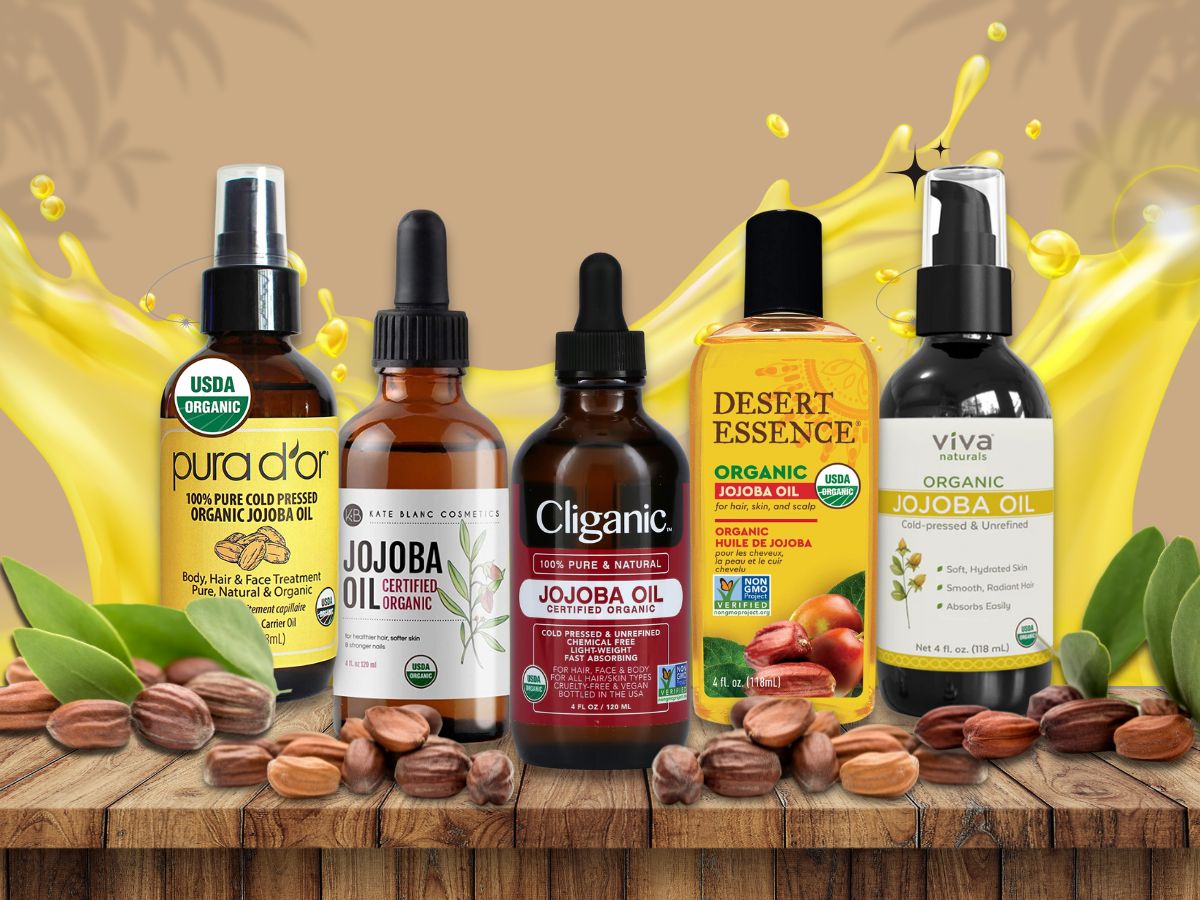We hairdressers spend a good long while studying ingredients in school. This includes everything from the shelf life of preservatives to integrating natural oils. As a result, we tend to get the “insider’s scoop” long before something becomes trendy.
Jojoba oil for hair is the best example of this phenomenon. This natural oil has been a huge part of the beauty and cosmetics industry since the 1960s. And yet, it’s only very recently that the general public has taken notice.
Erin Black is a stylist and salon owner of Lucky Lu’s in Denver, CO. “Jojoba oil, and other smaller molecular oils, are a good choice for all hair types… The molecular structure makes it easier to penetrate the hair strands for maximum hydration,” she says.
“Because it is able to absorb more effectively, your hair will have less of a film left on it also!” she adds.
Wondering if this product lives up to its massive new fanbase? You’ve come to the right place. I spoke with other expert hairstylists about what you can really expect from jojoba oil.
In this guide, you’ll learn all about:
- What jojoba oil is. An oil made by cold-pressing seeds from the jojoba tree. But the texture is very rich, almost like liquid wax. And yet it’s never greasy or sticky.
- Why use jojoba oil. A slew of proven benefits like reducing hair loss and fighting dandruff. I’ll also dig into the science that backs it all up.
- How, when, and where to use jojoba oil. So many ways! You’ll find step-by-steps for scalp treatments and more using pure jojoba oil.
- Who can use jojoba oil. Anybody who wants to rejuvenate their hair and scalp with natural products.
- Mixing and buying advice for jojoba oil. My favorite mixes to help your hair get even healthier. Plus, my pro tips for buying the best oil.
- Frequently asked questions about jojoba oil. I’ll separate fact from fiction when it comes to growing hair faster, stripping hair color, and so much more.
What is Jojoba Oil?
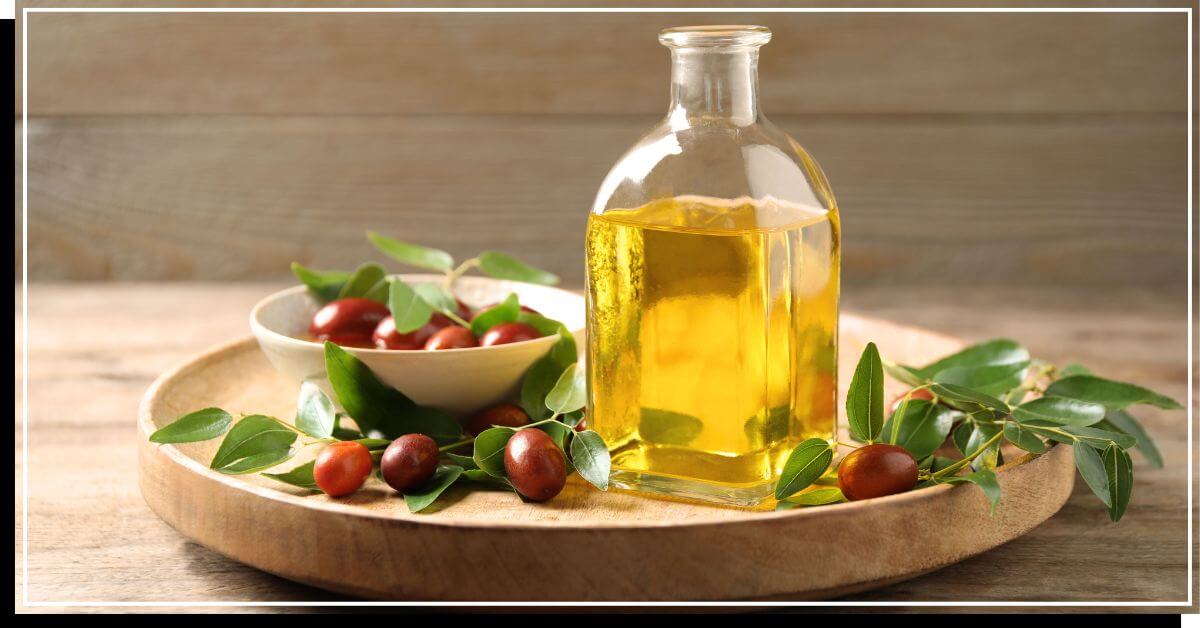
Jojoba oil comes from cold-pressing seeds of the jojoba tree. It’s also known as Simmondsia Chinesis. It’s been hailed among dermatologists, estheticians, and cosmetologists since the early 1960s.
Modern science has shed a light on why jojoba oil is so powerful. It’s jam-packed with nutrients your hair and scalp need to stay healthy. This includes vitamin E and essential fatty acids. (source)
Even better, jojoba oil is molecularly similar to your scalp’s natural oil. This oil, called sebum, is crucial to a healthy scalp and hair. The lubrication and nutrients it provides keep your hair soft, shiny, and tangle free. Sebum also keeps you from getting dandruff or dry scalp.
Jojoba oil offers these benefits and more because of its striking resemblance to sebum. (source)
Benefits of Jojoba Oil
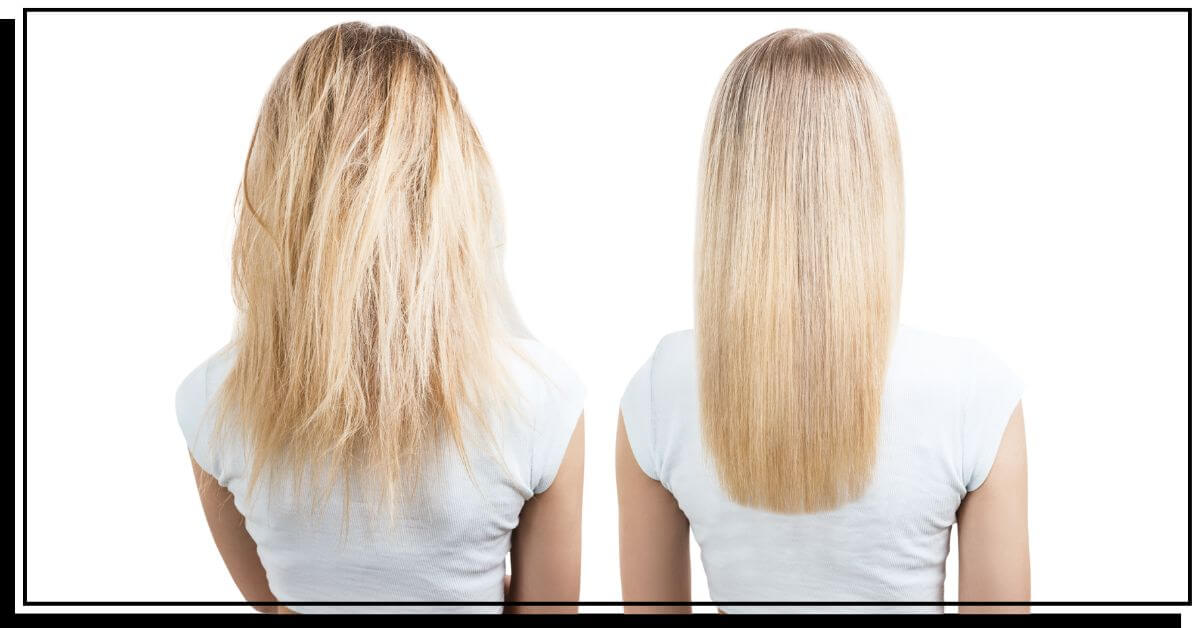
Jojoba oil is packed with fatty acids, vitamin E & antioxidants. It is an anti-inflammatory, it relieves soreness, itching, dandruff, scalp acne & psoriasis. Jojoba is water soluble so it’s easily removed from the scalp and won’t leave a residue. (source)
Moisturizes from the inside out. Every strand of your hair basically “recognizes” jojoba oil’s similarity to natural oils, and welcomes it in like an old friend. The deep absorption moisturizes from the inside out. This adds lots of softness and shine without weighing you down. (source)
Reconstructs and repairs hair. Sebum helps lubricate and moisturize hair from scalp to ends. But with thicker and curlier hair, it never reaches your mid-shafts or ends. Jojoba oil adds the building blocks of nutrition your hair is otherwise missing. (source)
Amplifies smoothness and shine. Your hair looks smooth and shiny when it’s healthy. Basically, every layer of your hair shaft has the moisture and protein it needs. Jojoba oil infuses your hair with both, leading to smooth and shiny tresses every day. (source)
Anti-hair loss. The cause of hair loss can be many things. If your hair is thinning due to breakage or damage, jojoba oil is your new best friend. It strengthens your strands and the hair follicle itself. One study found regular jojoba oil use significantly reduced hair loss due to breakage. (source)
Boosts hair growth. To be clear, jojoba for oil can improve thickness and length. But it can’t make your hair grow faster, according to one recent study. (source) Basically, jojoba oil protects your hair from a lot of damage and breakage. If your hair is slow-growing because of this, using jojoba oil enables it to grow longer and thicker.
Anti-dandruff, plus it helps with eczema and dry scalp. Jojoba oil promotes a healthy scalp thanks to antibacterial and antifungal properties. Whether you tend to have oily or dry skin, this oil can bring the pH into balance. (source)
Detangles and prevents new tangles. A small amount of jojoba oil will sit outside your hair shaft, on the exterior. This layer is called the cuticle. Picture it as tiny clear scales on every strand of hair. Brushing or combing too hard raises the cuticle, causing tangles. Jojoba smooths it down to detangle and prevent new tangles. (source)
Potential Downsides

I’ve yet to meet a person who can’t benefit from jojoba oil in at least one way. But you can always have too much of a good thing.
Jojoba oil does absorb into your hair better than any synthetic compound. But it’s not 100% absorption. A small amount stays on your hair’s exterior. For this reason, it’s possible to accidentally use too much and end up with a greasy hairstyle for the day.
Past studies and tests have found little to no contraindications. Allergies to jojoba oil are rare, especially with topical use. (source)
How to Use Jojoba Oil for Hair
It’s true that jojoba oil can benefit every hair type in at least one way. The thing is, every hair type has certain needs. How do you get the most positive impact from using jojoba oil for hair? By starting with applications suited to your hair type.
Jojoba Oil Hair Mask

Unlike other natural oils, I find that jojoba oil doesn’t make the best hair mask on its own. You’ll get much better results by using it as a carrier oil or hair mask ingredient.
When: Between once a month and once a season if you have fine or natural hair. Up to twice a month if you have coarse, heavily processed, or frizzy hair.
Where: Focus on your ends, which tend to need the most reconstruction. Work your way towards your mid-shafts as you use the oil, since this area is usually healthier.
How:
- Mix 1-2 tablespoons of jojoba oil with your other chosen ingredients. You can add it to your regular conditioner, your usual hair mask recipe, or add a few drops of an essential oil like rosemary or rosehip. You may need to warm the jojoba oil before it’ll mix well, either in your hands or with low heat on the stove.
- Apply your mask, ideally to dry hair. Your hair can soak up more nutrients when it’s dry because it’s not saturated with water. Use whatever application method you like. Starting at your roots and working down is fine. My ends are often very dry, so I start there personally.
- Use your hands or a wide-tooth comb to work the mask through your hair evenly.
- Put your hair up in a clip, towel, shower cap, or bag. Insulating with a towel, cap, etc. can help your hair absorb the mask better. But you’ll still see benefits without wrapping it up.
- Allow to sit for 30 to 60 minutes. I know some people like to sleep in hair masks. I suggest starting with 30 – 60 minutes though. Then, if you like, you can experiment with longer time periods. The goal is confirming you won’t get itchy or uncomfortable sleeping with the mask on.
- Rinse your hair, then shampoo and condition as normal. You should notice a big reduction in frizz and tangles, plus a boost to shine and softness.
Pre-Shampoo Treatment
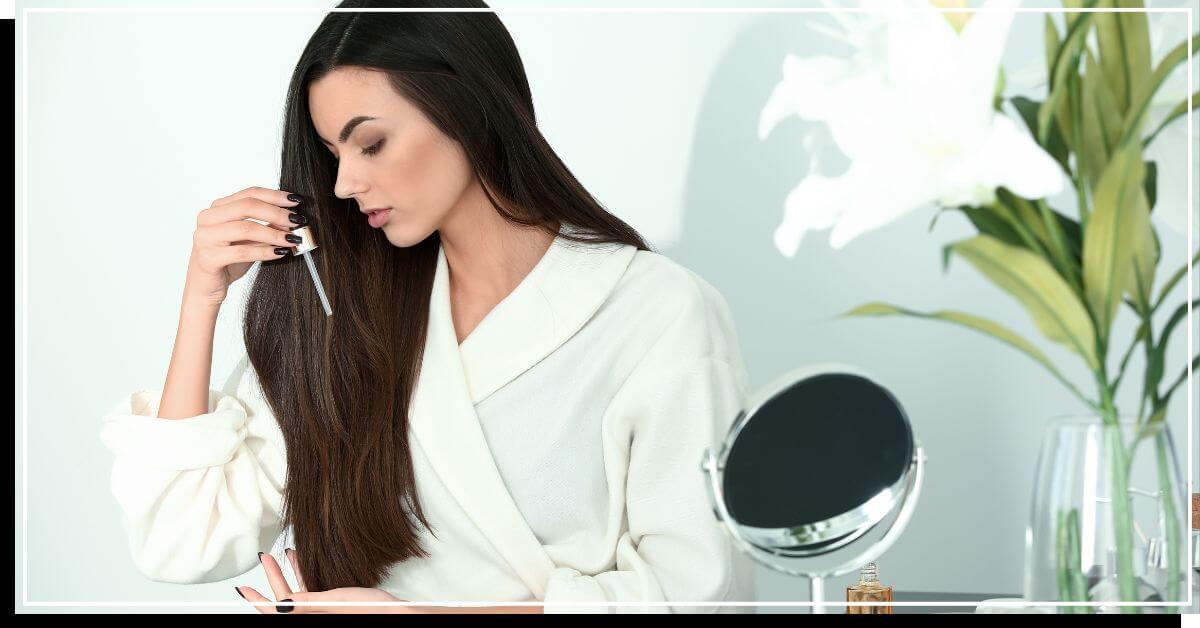
Like coconut oil, applying before you shower can protect your hair from damage, breakage, and frizz caused by washing. Your hair is most fragile when it’s wet. If you feel like you lose a ton of hair when you wash it, this treatment is your new best friend.
When: Before washing your hair. This is safe to do before every wash, but you can do it every other wash or whatever you like.
Where: Your entire head. You aren’t trying to look like you dunked your head in jojoba oil. But you do want everything from roots to ends covered in an even, light layer.
How:
- Start with dry hair right before you’re planning to wash it. It doesn’t matter how dirty your hair is. Been a week since your last hair wash? No problem. Follow these same steps.
- I like to split my hair in half by parting down the center and pulling each half in front of a shoulder. Section your hair however you like to make this easier.
- Rub a few drops of oil between your hands. I suggest 1-3 for shorter hair, 3-5 for medium hair, and 6-8 for long hair. If your hair is long and coarse, you may want a few more drops.
- Work the oil through your hair, from roots to ends. No need to get your scalp. Feel free to brush or comb through to evenly distribute, but it’s not absolutely necessary.
- Shampoo and condition your hair as normal. The goal here is not using so much jojoba oil that you need to do extra washing. The oil is just there to protect from any damage or breakage caused by scrubbing.
- Special note- You may notice more hair loss in the shower the first time you do this, or if you don’t do it often. The oil basically “catches” any hairs that have already fallen out of your head, but are lost or tangled with the rest.
Don’t stress if you notice more hair fall the first time. It just means you already had a lot of dead hair that needed to be brushed away. There should be far, far less hair fall if you do this regularly.
Shampoo and Conditioner
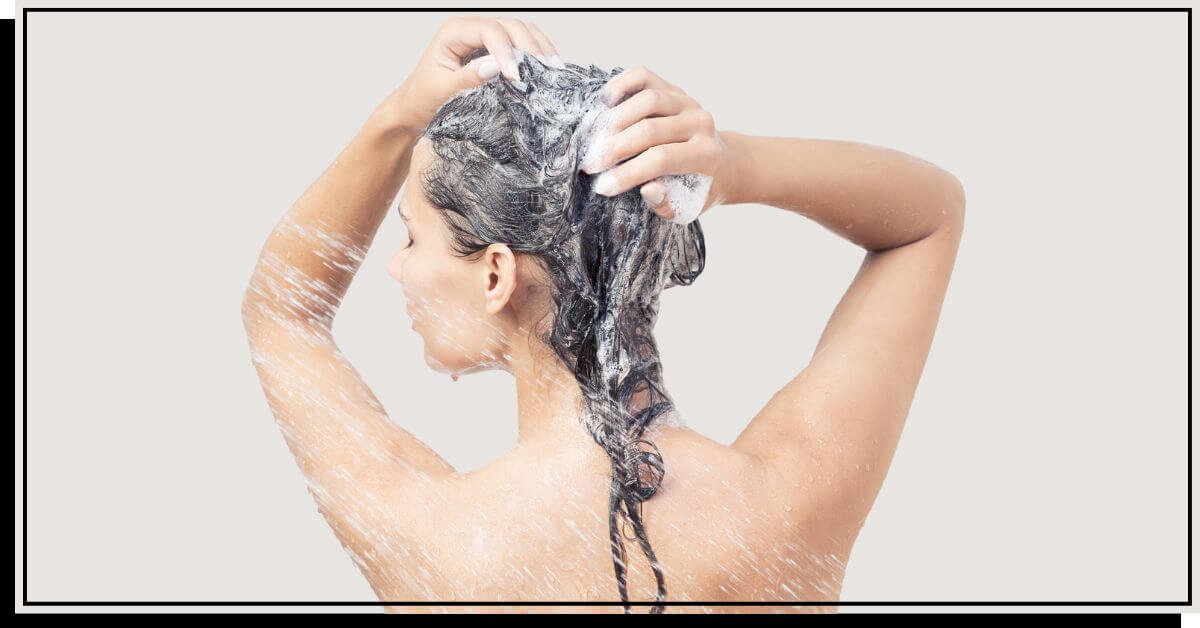
Jojoba oil, unlike coconut oil, is light enough to be mixed with shampoo and/or conditioner.
When: This is safe to do every time you wash your hair. But if you have fine hair, start with every other wash to avoid excess oil.
Where: Shampoo is designed to clear your scalp and roots, so focus there. Conditioner, on the other hand, is geared towards your mid-shafts and ends.
How:
- To start, I recommend not adding jojoba oil straight into your shampoo and conditioner bottles. Start with adding 1-3 drops to the shampoo and then the conditioner in your palm. This lets you dial in the right amount before you potentially ruin an entire bottle.
- Once you have the oil and shampoo or conditioner in your palm, emulsify it all together. This ensures all of your hair gets an equal amount of product.
- Shampoo, condition, rinse, and style as you normally would. You should notice more softness, reduced dry time, and a shine boost. If not, you may need to do this a few times before getting noticeable results.
Leave-in Conditioner
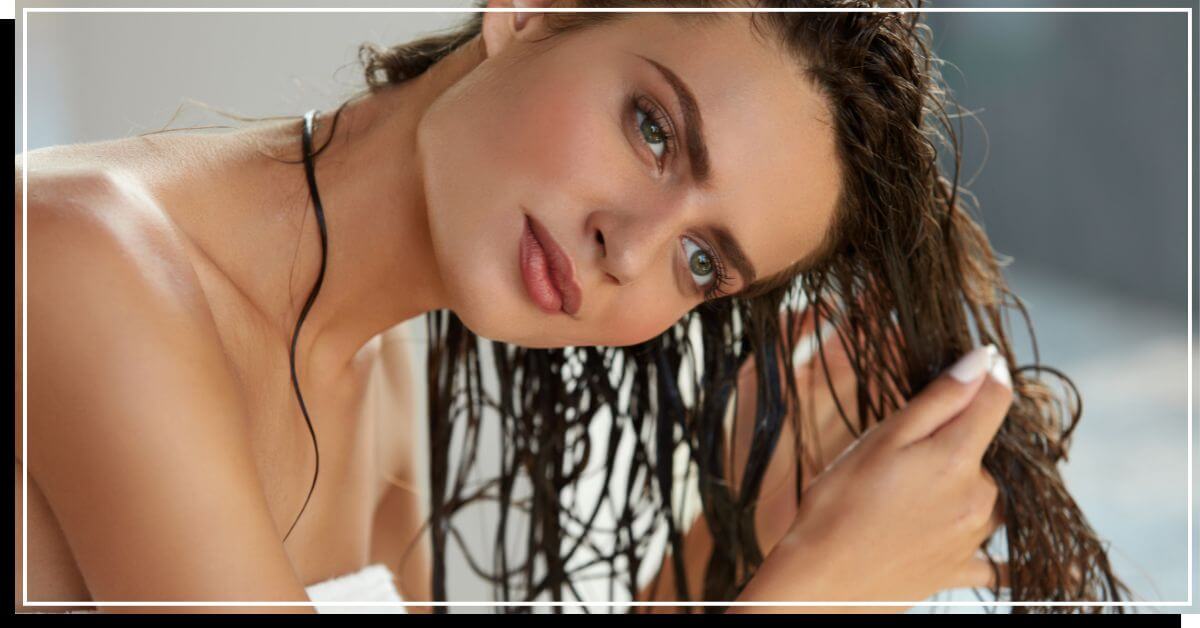
Jojoba oil makes an excellent natural heat protectant. (source) It also detangles and adds softness, making it a fabulous leave-in conditioner.
When: Anytime your hair feels a little rough or straw-like after you wash it.
Where: Mostly your mid-shafts and ends. If your hair is heavily processed, you can add a drop for your roots too.
How:
- Start with clean, damp hair and section your hair. I just part mine down the middle and use 2 sections for this application. But feel free to do more or less based on your hair’s thickness.
- Consider your hair length. You’ll only need 2-3 drops for short hair, 3-5 drops for medium-length hair, and 6-12 for long hair. Remember you can always add more if the first round isn’t enough.
- Emulsify the oil in your hands. You can also warm it up on the stove or in the microwave on the lowest heat.
- Starting at your ends, apply the jojoba oil. Try sandwiching your hair between your hands and slide them down to start. Repeat this process a couple times, starting slightly higher up on your hair each time. This deposits the majority of the oil on your ends, (which need it most) and avoids overloading your roots.
- Style as desired. Because this oil is a heat protectant, blow-drying or heat styling your hair in any way should be a bit faster. You should also notice more shine, less tangles, and less frizz.
Styling Product

A very small amount of jojoba oil can replace many synthetic hair serums. Using it this way will add shine and softness, especially after blow-drying or other heat styling.
When: Unless your hair is fine, you can do this every time you style your hair. If you do have fine hair, save this technique for special occasions.
Where: Focus on your mid-shafts and ends. If you have very frizzy, dry, coarse, or heavily processed hair, you can do a small amount on your roots too.
How:
- Decide whether to use the jojoba oil on its own or mix with another styling product. You can emulsify it with gel, creams, and most mousses. But you can also apply a few drops with nothing else.
- Apply before using heat. If you’re blow-drying, apply to your hair while damp. If your hair is already dry and you’re curling or flat ironing it, apply while dry. Note that you’ll need about 25% less on dry hair. Start with just a few drops and work your way up.
- Use a brush or wide-tooth comb to really distribute the product evenly. The main goal here is shine, smoothness, and protection from heat damage. So all your hair needs a light, even layer.
- Style as desired. Doing your hair now should be a little faster thanks to the heat protectant qualities. If you straighten your hair, it can be nice to emulsify 1 drop in your hands and run it through your ends when you’re done. But I suggest sticking with hairspray to finish a head of curls.
Jojoba Oil Scalp Treatment
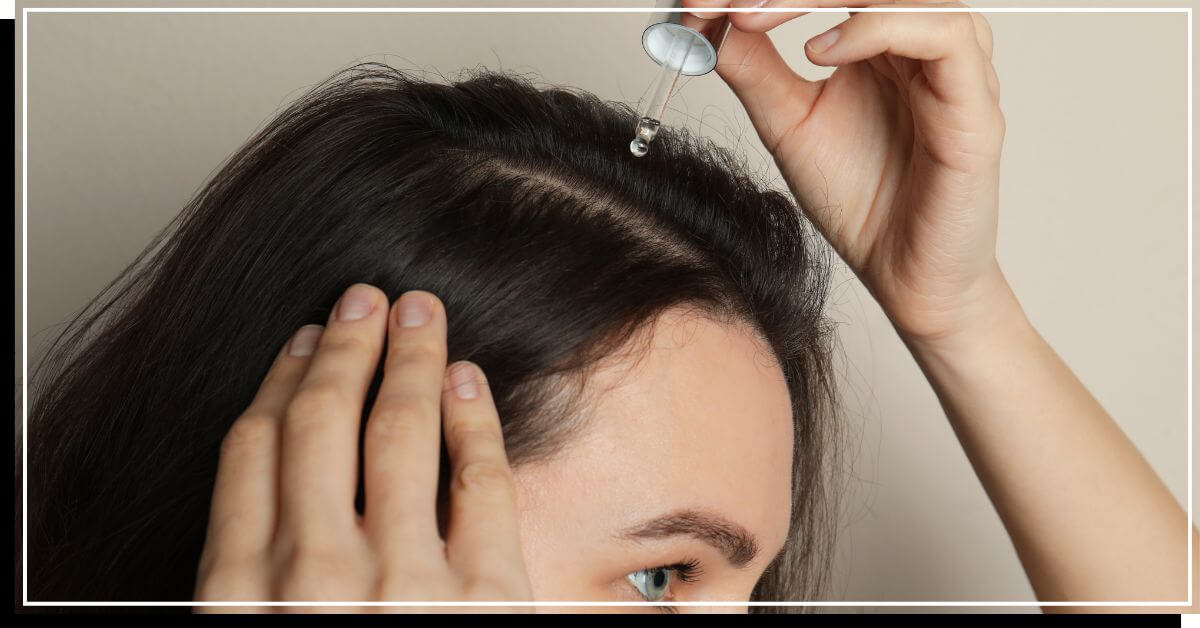
Jojoba oil is great for treating dry scalp. It’s also great for treating dandruff. Best of all, jojoba oil doesn’t clog hair follicles or pores because it’s non-comedogenic. (source)
When: Anywhere from once a week to once a season. Start with less frequently and increase your cadence if you don’t see immediate results.
Where: All over your scalp, but not on your hair.
How:
- Section your hair and clip each out of the way. I like to do 4. I part my hair in the center from front to back, splitting my hair in half. Then I part from ear to ear. Doing this will create 1 section over each of your ears and split the back of your hair in half, for a total of 4 sections. But do whatever works!
- Unclip one section. I usually start in the back to get the harder part out of the way, but the order doesn’t matter.
- Get 1-3 drops of pure jojoba oil on your fingertips and work it into your scalp. Focus on the section you unclipped. You don’t want your scalp to be dripping wet with oil, but you do want a light, even layer across your skin.
- Repeat for the remaining 3 sections. You can clip up each section as you finish, or leave them down.
- Take a few minutes to give yourself a full scalp massage. I like to start at my temples and front hairline, then work my way back to the nape of my neck. The massage helps the jojoba oil absorb better and stimulates blood flow to your scalp.
- Allow this treatment to sit for 20-30 minutes. Wrap your hair in a towel, shower cap, or plastic bag if you have one. But it’s not necessary if you don’t have one.
- Wash, condition, and style your hair as you normally would. Your scalp should feel less irritated, and you should notice less flakes in the next week. If the symptoms return within a week or a month, that’s your signal to do another scalp treatment.
Beard and Mustache Treatment

Jojoba oil is great for facial hair too! It’s very common for beard and mustache hair to act unruly. This is because facial hair often has a different chemical structure than the hair on your head. (source) The solution is infusing these wiry hairs with the moisture they don’t naturally carry.
When: It’s safe to use jojoba oil on your beard and mustache every day. Start with once or twice a week and increase to daily if needed.
Where: Your entire beard and mustache, and even your sideburns if that hair is misbehaving.
How:
- Start with wet or dry facial hair. If it’s dry, don’t wet it down. If you’re fresh out of the shower, just do a quick towel dry. Damp is fine, soaking wet not so much.
- Consider how much facial hair you have and use the corresponding amount. Stubble or short mustaches/beards only need 1-3 dops. You’ll want 3-6 for medium-length, and 8-12 for very long facial hair.
- Massage the oil into the skin under your facial hair first. Then run your fingers through your beard and/or mustache. You want every strand of hair fully covered, but not dripping wet or oily looking.
- If you like to use a beard comb or brush, now’s the time. You can also apply the oil directly to it and then brush through. But you don’t absolutely need one of these to do this treatment!
- That’s it. No need to rinse after a set period of time. I always recommend washing your face at least once daily, so be sure to do that before applying oil tomorrow. Your facial hair should be softer, more manageable, and less itchy.
Hair Type Considerations
Jojoba oil can be used on all hair types, whether you have natural hair or color treated hair. The molecules are smaller than most natural oils, such as coconut oil. So, it can absorb more deeply than most natural oils.
In a nutshell, even if you have extremely fine hair, you should consider adding jojoba oil to your hair care regimen. Let’s take a closer look at each hair type now.
Thick, Heavily Processed, or Curly Hair

If you have thick, heavily processed, or curly hair, you have the most versatility with jojoba oil. Every single treatment could potentially benefit your hair and scalp.
Plus, your hair needs more moisture and protein than any other hair type, so using too much is harder. You have more flexibility with every application.
I know it might sound odd to hear this oil is fabulous for natural hair, heat damaged hair, and dry hair. But its similarity to your scalp’s natural oils and teeny-tiny molecules makes it a great choice for all these hair types.
Gray hair falls into this category too. When a strand of hair goes gray, that follicle also produces less oil. (source) That’s why gray hair feels so wiry. Jojoba oil infuses these hairs with what they’re missing, making them behave much better.
In short, consider the benefits you want most and start with those applications. You might try doing a scalp treatment and a quick hair mask at the same time. For this application, wash everything out after 20-30 minutes.
You could see how you like mixing jojoba oil into your shampoo, conditioner, or both.
No matter which way you do it, you should notice more softness and shine. If not, increase the frequency or add jojoba oil as a styling product too.
Fine or Oily Hair

You have to be careful with natural oils if you have fine hair or a naturally oily scalp. In these cases, adding more oil usually isn’t helpful.
Jojoba oil is better suited to fine hair than coconut oil, for example. Jojoba oil molecules are smaller, so they absorb into your hair better than coconut oil.
But you’ll still want to start with using a small amount, and not too often. Applying too much jojoba oil for hair will just create a heavy, greasy feeling. So what’re the best applications for you? Try pre-shampoo treatments, mixing with shampoo/conditioner, and scalp treatments.
Dandruff is the result of an oily scalp, not a dry scalp. (source) So, dandruff is very common if you have finer hair. Jojoba oil is antifungal and balances your scalp’s pH levels. That’s why I recommend jojoba oil scalp treatments for dandruff and oily scalps.
Start with doing them every 2-4 weeks depending on the severity of your flakes. I swear by this treatment during humid summers when my head gets extra sweaty/oily.
Medium Density or Color Treated Hair
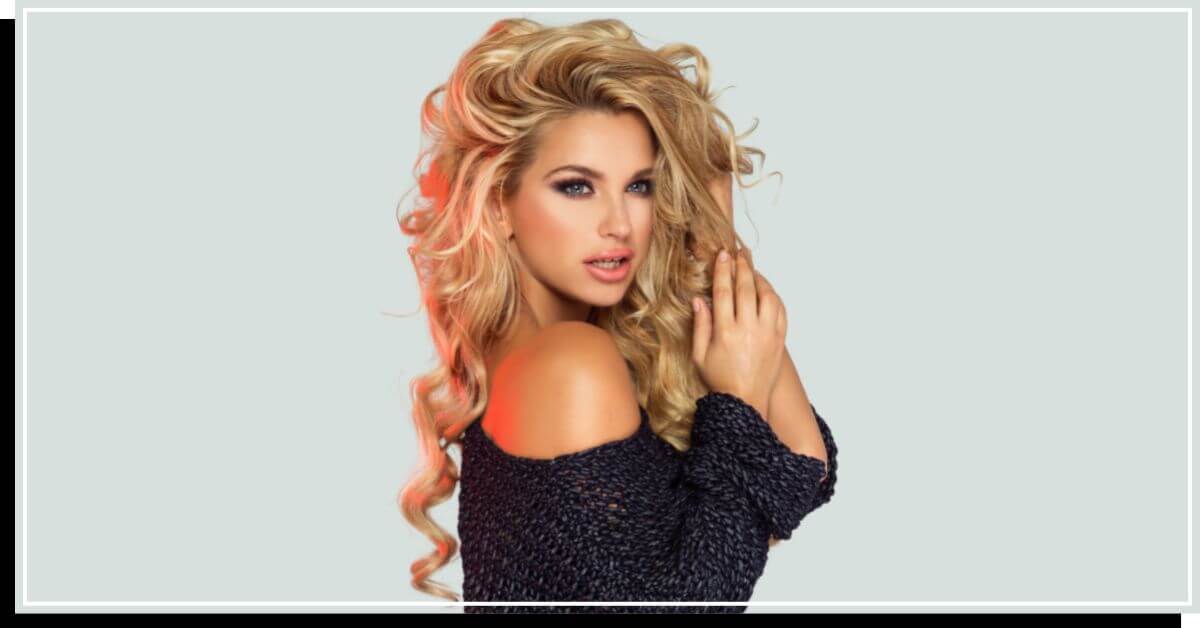
In my experience, you’ll see the most benefit from jojoba oil for hair if you’re in this category. Medium density hair, frizzy hair, and color treated hair tend to be lacking in moisture, but not protein. (source)
And though jojoba oil can help replace some of that missing protein, it’s best at replacing moisture.
You may see benefits from every single application method. But odds are you won’t need to do every single one on a regular basis. My hair falls into this category, and I mainly use jojoba oil in 2 ways: as a pre-shampoo treatment and as a leave-in conditioner.
Doing these 2 every weeks or so keeps my hair in great shape. My scalp tends to get flaky during the weather transitions. So, I do a scalp treatment when the seasons change.
I suggest picking 1 or 2 applications and trying them out. If you like the results, stick with that routine for the rest of the season. Re-evaluate once the weather changes. Not seeing enough of a change? Try increasing the frequency or trying a different application.
Everyone’s different and there are no wrong answers!
Best Oils to Mix with Jojoba Oil
I mentioned earlier that jojoba oil makes an amazing carrier oil. A carrier oil is any lightly scented natural oil used to dilute more potent essential oils.
Jojoba oil absorbs deep into your hair, benefits your scalp, and lubricates your hair’s cuticle layer. It’ll also add a turbo-boost to any oil you mix it with. Here are my top 3 favorites…
Tea Tree Oil: Pure tea tree oil is anti-inflammatory, anti-fungal, and antimicrobial. (source) But it can’t be applied directly to the skin. Add 1-3 drops of tea tree oil per tablespoon of jojoba oil. This mix is a powerful natural scalp treatment that helps with dandruff, eczema, and dry scalp. (source)
Rosehip Oil: Rosehip oil is packed full of vitamins, plus omegas 3, 6, and 9. (source) The thing is, rosehip oil has a different composition than jojoba. Rosehip oil sits on the outer layer of your hair… Unless it’s added to a powerful carrier oil like jojoba. This gives you the full spectrum of nutrition for your tresses.
Mix ¾ tablespoon of rosehip oil with one tablespoon of jojoba oil. Double both quantities if you have long or thick hair. This can be applied as a hair mask, leave-in conditioner, scalp treatment, or beard/mustache treatment.
Argan Oil: Argan oil reigns supreme when it comes to natural oils for hair. It has the smallest molecules, meaning it nourishes your hair deeper than any other oil. (source) Argan oil has more antioxidants than jojoba, while jojoba does a better job of adding weightless shine.
Combine these two in even parts to create the ultimate scalp treatment, hair mask, or beard/mustache treatment.
Advice on Buying Jojoba Oil for Hair

Now that you know all the amazing ways to use jojoba oil for hair, you’re ready to shop. But you have to shop smart because dupes and knockoffs are all too common. Here are the 6 major things to look for, whether you want jojoba oil for your hair, scalp, or facial hair:
Color- Pure jojoba oil should be a warm and golden yellow in tone. It’s still transparent but has a definite golden hue. Avoid any jojoba oil that’s crystal-clear. This is a good indication of additional processing, which removes many beneficial properties. (source)
Scent- Virgin unrefined jojoba oil has little to no scent, depending on the seeds it’s extracted from. A faint nutty or smoky aroma is normal. Or you may detect no scent at all. So long as the jojoba oil is the right color, lack of scent doesn’t indicate refinement. (source) But if reviews mention any kind of funky odor—sour, fishy, or funky—steer clear.
Absorbency- Jojoba oil knockoffs use a small amount of pure oil and mostly synthetic chemicals. But how do you spot this before you buy? Check the reviews. Jojoba oil has a high absorbency rate. If reviews mention that the oil doesn’t seem to absorb, you’re probably looking at a knockoff.
Extraction Method- Always look for cold-pressed jojoba oil for hair. Heat-pressing allows companies to produce more quickly, but it destroys many beneficial aspects of the oil. (source) I’ve found no benefit to using heat-pressed jojoba oil.
Price- For cold-pressed organic jojoba oil, expect to pay between $1.50 and $5.00 per fluid ounce. The price usually depends on whether the oil is certified organic. And as with most things, you can save a bit by buying in bulk. If you see jojoba oil priced much higher or lower than this range, something’s off. I would avoid those.
Sourcing- Especially for natural products like this, sustainability is crucial. I always seek out brands who are certified to be sustainable, organic, and cruelty-free. I feel that choosing not to make these commitments is a red flag for any company.
I’ve received expired or defective products from these kinds of brands more than once, so I prefer to play it safe. Plus, nothing feels better than nourishing your hair while knowing the product is sustainably sourced.
Frequently Asked Questions
Does jojoba oil fade hair color?
No, jojoba oil does not fade hair color—it can actually help your color last longer. (source)
I have a theory on why this myth persists. One of the best things about using jojoba oil for hair is how deeply it absorbs into your hair. As I said earlier, this oil is similar to the scalp’s natural oils on a molecular level.
And that’s why jojoba absorbs so well into your hair. Some people take this thinking a step further. The oil penetrates deeply into the hair shaft. Surely it must force some of the color molecules out of the hair shaft… right?
Wrong. The second reason this question persists is the popularity of temporary, demi- and semi-permanent color. These colors only last for a couple weeks before fading. But it’s common for people to start using higher end products (like jojoba oil) when they get a major hair makeover (like a fun semi-permanent color).
So, the association between jojoba oil and fading hair color persists. But research continues to show that jojoba oil extends the vibrancy, not fade it. (source)
How often should you use jojoba oil in your hair?
Depending on how you use it, you can use jojoba oil daily, weekly, or monthly.
Monthly or weekly scalp treatments can improve your skin’s health. But doing them more often than weekly won’t make a difference.
As a styling product, you’ll want to use jojoba oil every few days or even daily. This is especially true if you have thick or heavily processed hair.
The great thing about this oil is that it’ll benefit your hair, no matter what type. I recommend starting with adding it to your shampoo or conditioner weekly if you have fine hair. Try it as a leave-in conditioner if you have curly, thick, or heavily processed hair.
Is your hair middle of the road in terms of thickness and damage? Do a jojoba oil hair mask every 2 weeks and see what kind of an impact it has.
These are just starting points, though! Feel free to dabble in different applications and treatments to find what works best for you. If you ever feel like you’ve used it too often, just wash and condition your hair normally.
How long does jojoba oil take to work?
You should only need to use jojoba oil once to notice it working. I find this is true for any application. Whenever I use it myself or on a client at the salon, I notice an immediate difference.
If you apply jojoba oil and don’t notice a difference in your hair’s softness, shine, or smoothness, there are a couple possible reasons. The same is true if you don’t notice any improvements following a scalp treatment.
It’s most likely how much you used. Jojoba oil absorbs into the hair extremely well. So if your locks are lacking in nutrients or moisture, that oil is going to absorb fast. Synthetic hair serums sit on the outside of your hair, so you often need less before noticing the added shine.
The second likely cause is your timing. If you used the right amount, it probably didn’t sit for long enough. This applies to any treatments you wash out. Try doing the treatment again for an additional 10 minutes.
Finally, it might be expired. On the rare occasion I’ve encountered expired jojoba oil, the sour aroma is very strong—and I throw it out immediately. Expired products don’t offer any of the benefits they once did.
How do you know if jojoba oil is expired?
You know jojoba oil is expired if it:
- Has a sour, putrid, or strong smell
- Has been stored for longer than 2-3 years (even in perfect conditions, jojoba oil will expire within this timeframe) (source)
- Has visibly changed color since you first bought it
You shouldn’t ever take the risk of using expired jojoba oil on your hair. Doing so can deplete your hair and scalp’s natural levels of vitamins. (source)
Do you apply jojoba oil to wet or dry hair?
You can apply jojoba oil to wet hair as a hair mask, shampoo, conditioner, or leave in conditioner. On dry hair, apply jojoba oil as a pre-shampoo treatment, styling product, or beard/mustache treatment.
Basically, either way is fine—it just depends on what type of application you’re doing. Remember that you’ll need far less oil for dry applications. Using too much on dry hair can cause a dull, greasy appearance.
Does jojoba oil help hair growth?
Jojoba oil can help your hair grow longer and thicker, but not faster. (source) Studies comparing its effects on hair loss to Rogaine and peppermint oil (2 proven options to grow hair faster) haven’t found much.
Every time, Rogaine and peppermint oil are more effective for speeding up hair growth. (source) But if you’re looking to grow your hair longer or thicker, jojoba oil should do the job.
Which is better, argan or jojoba oil for hair?
Experts agree that argan oil and jojoba oil for hair are equally beneficial. Both are essential oils rich in vitamin E and essential fatty acids. These nutrients promote hair and scalp health in quite a few ways.
I highly recommend trying both to see which you like better. Argan oil is a tad higher in antioxidants, which are great for gray and color treated hair. Jojoba oil is almost identical in many ways to your scalp’s natural oils. So it’s perfect for weightless moisture. (source)
Personally, I keep a bottle of both in my bathroom. I usually mix both to enjoy the best of both worlds. You can also try alternating which one you use every day, but both oils are great for all hair types!
